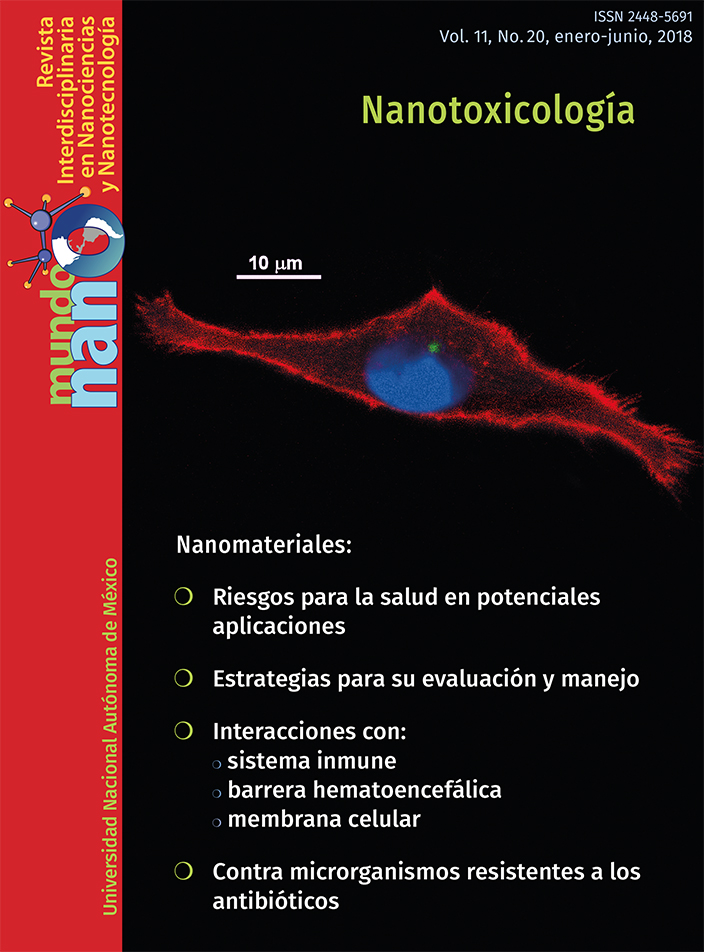Perfil fisiológico de los nanomateriales
Resumen
Hoy en día uso de nanomateriales (NMs), ha proporcionado aplicaciones en múltiples áreas como la medicina, cosmetología, electrónica y otras, dando lugar a la generación de exitosos productos comerciales. Sin embargo, aún existe controversia en la toxicología promovida por los NMs, debido a que la naturaleza del material, su tamaño, concentración e interacción con estructuras fisiológicas, podría afectar de manera negativa al organismo. En este sentido, las investigaciones en nanotoxicología, incluyen modelos fisiológicos ex vivo, que permiten obtener información del efecto biológico de los NMs en órganos y tejidos, por ejemplo corazón, hígado, riñón, vasos sanguíneos, aparato digestivo, respiratorio, entre otros. Los resultados de dichos abordajes fisiológicos se obtienen de forma relativamente rápida, con un costo comparativamente bajo y proporcionan información importante de los mecanismos de acción involucrados en el órgano diana. En esta revisión, se describen algunos modelos fisiológicos que pueden aportar información relevante en el campo de la nanotoxicolgía y como se podrían complementar a través de modelos in silico. Asimismo, se presenta como caso de estudio, el trabajo realizado por nuestro grupo de investigación en referencia al efecto biológico de las nanopartículas de plata (AgNPs) haciendo uso modelos de corazón aislado y perfundido, anillos aislados de vasos sanguíneos y de vías respiratorias.
Citas
Bachler, G., Von Goetz, N., Hungerbühler, K. (2013). A physiologically based pharmacokinetic model for ionic silver and silver nanoparticles. International Journal of Nanomedicine, 8: 3365. http://doi.org/10.2147/IJN.S46624
Basak Engin, A., Neagu, M., Golokhvast, K., Tsatsakis, A. (2015). Nanoparticles and endothelium: An update on the toxicological interactions. FARMACIA, 63(6): 792. http://www.revistafarmacia.ro/201506/art-02-Tsatsakis_792-804.pdf
Bekersky, I. (1983). Use of the isolated perfused kidney as a tool in drug disposition studies. Drug Metabolism Reviews, 14(5): 931. http://doi.org/10.3109/03602538
Bekersky, I., Fishman, L., Kaplan, S. A., Colburn, W. A. (1980). Renal clearance of salicylic acid and salicyluric acid in the rat and in the isolated perfused rat kidney. The Journal of Pharmacology and Experimental Therapeutics, 212(2): 309. http://www.ncbi.nlm.nih.gov/pubmed/7351644
Bell, R. M., Mocanu, M. M., Yellon, D. M. (2011). Retrograde heart perfusion: The Langendorff technique of isolated heart perfusion. Journal of Molecular and Cellular Cardiology, 50(6): 940. http://doi.org/10.1016/j.yjmcc.2011.02.018
Cameron, J. N. (1986). Principles of physiological measurement, Academic Press, Estados Unidos de America, 278. http://doi.org/10.1016/B978-0-12-156955-6.50 020-7
Christensen, F. M., Johnston, H. J., Stone, V., Aitken, R. J., Hankin, S., Peters, S., Aschberger, K. (2010). Nano-silver – feasibility and challenges for human health risk assessment based on open literature. Nanotoxicology, 4(3): 284. http://doi.org/10.3109/17435391003690549
Chuang, K.–J., Lee, K.–Y., Pan, C.–H., Lai, C.–H., Lin, L.–Y., Ho, S.–C., (2016). Effects of zinc oxide nanoparticles on human coronary artery endothelial cells. Food and Chemical Toxicology, 93: 138. http://doi.org/10.1016/j.fct.2016.05.008
Dhein, S. (2005). Practical methods in cardiovascular research: The Langendorff Heart. Springer, Berlin, Heidelberg. http://doi.org/https://doi.org/10.1007/b137833
Dong, J., Ma, Q. (2015). Advances in mechanisms and signaling pathways of carbon nanotube toxicity. Nanotoxicology, 9(5): 658. http://doi.org/10.3109/17435390. 2015.1009187
Epstein, F. H., Brosnan, J. T., Tange, J. D., Ross, B. D. (1982). Improved function with amino acids in the isolated perfused kidney. The American Journal of Physiology, 243(3): F284. http://doi.org/10.1152/ajprenal.1982.243.3.F284
European Comission (2012). Types and uses of nanomaterials, including safety aspects. Communities. Bruselas. https://ec.europa.eu/health//sites/health/files/nanotechnology/docs/swd_2012_288_en.pdf
Gaffet, E. (2011). Nanomaterials: A review of the definitions, applications, health effects. How to implement secure development. hal archives-ouverte.fr. https://hal. archives-ouvertes.fr/hal-00598817
Galanzha, E. I., Tuchin, V. V., Zharov, V. P. (2007). Advances in small animal mesentery models for in vivo flow cytometry, dynamic microscopy, and drug screening. World Journal of Gastroenterology, 13(2): 192. http://doi.org/10.3748/WJG.V13.I2.192
Ge, G., Wu, H., Xiong, F., Zhang, Y., Guo, Z., Bian, Z., Xu, J., Gu, C., Gu, N., Chen, X., Yang, D. (2013). The cytotoxicity evaluation of magnetic iron oxide nanoparticles on human aortic endothelial cells. Nanoscale Research Letters, 8(1): 215. http://doi.org/10.1186/1556-276X-8-215
Gerloff, K., Pereira, D. I., Faria, N., Boots, A. W., Kolling, J., Förster, I., Albrecht, C., Powell, J. J., Schins, R. P. (2013). Influence of simulated gastrointestinal conditions on particle-induced cytotoxicity and interleukin-8 regulation in differentiated and undifferentiated Caco-2 cells. Nanotoxicology, 7(4): 353. http://doi.org/10.3109/17435390.2012.662249
González, C., Salazar–García, S., Palestino, G., Martínez–Cuevas, P. P., Ramírez–Lee, M. A., Jurado–Manzano, B. B., Rosas–Hernández, H., Gaytán–Pacheco, N., Martel, G., Ali, S. F. (2011). Effect of 45nm silver nanoparticles (AgNPs) upon the smooth muscle of rat trachea: Role of nitric oxide. Toxicology Letters, 207(3): 306. http://doi.org/10.1016/j.toxlet.2011.09.024
Ko, E. A., Song, M. Y., Donthamsetty, R., Makino, A., Yuan, J. X.-J. (2010). Tension measurement in isolated rat and mouse pulmonary artery. Drug Discovery Today. Disease Models, 7(3-4): 123. http://doi.org/10.1016/j.ddmod.2011.04.001
Lem, K. W., Choudhury, A., Lakhani, A. A., Kuyate, P., Haw, J. R., Lee, D. S., Iqbal, Z., Brumlik, C. J. (2012). Use of nanosilver in consumer products. Recent Patents on Nanotechnology, 6(1): 60. http://www.ncbi.nlm.nih.gov/pubmed/22023078
Meek, M. E., Barton, H. A., Bessems, J. G., Lipscomb, J. C., Krishnan, K. (2013). Case study illustrating the who ipcs guidance on characterization and application of physiologically based pharmacokinetic models in risk assessment. Regulatory Toxicology and Pharmacology, 66(1): 116. http://doi.org/10.1016/j.yrtph.2013.03.005
Meiring, J. J., Borm, P. J. A., Bagate, K., Semmler, M., Seitz, J., Takenaka, S., Kreyling, W. G. (2005). The influence of hydrogen peroxide and histamine on lung permeability and translocation of iridium nanoparticles in the isolated perfused rat lung. Particle and Fibre Toxicology, 2(3). http://doi.org/10.1186/1743-8977-2-3
Mohamed, S. A., Radtke, A., Saraei, R., Bullerdiek, J., Sorani, H., Nimzyk, R., Karluss, A., Siervers, H. H., Belge, G. (2012). Locally different endothelial nitric oxide synthase protein levels in ascending aortic aneurysms of bicuspid and tricuspid aortic valve. Cardiology Research and Practice, 2012, 165957. http://doi.org/10.1155/2012/165957
Ramírez–Lee, M. A., Aguirre-Bañuelos, P., Martínez–Cuevas, P. P., Espinosa–Tanguma, R., Chi–Ahumada, E., Martínez–Castañón, G. A., González, C. (2018). Evaluation of cardiovascular responses to silver nanoparticles (AgNPs) in spontaneously hypertensive rats. Nanomedicine: Nanotechnology, Biology and Medicine, 14(2): 385. http://doi.org/10.1016/j.nano.2017.11.013
Ramírez–Lee, M. A., Espinosa–Tanguma, R., Mejía–Elizondo, R., Medina–Hernández, A., Martínez–Castañón, G. A., González, C. (2017a). Effect of silver nanoparticles upon the myocardial and coronary vascular function in isolated and perfused diabetic rat hearts. Nanomedicine: Nanotechnology, Biology, and Medicine, 13(8): 2587. http://doi.org/10.1016/j.nano.2017.07.007
Ramírez–Lee, M. A., Rosas–Hernández, H., Salazar–García, S., Gutiérrez–Hernández, J. M., Espinosa–Tanguma, R., González, F. J., Ali, S. F., González, C. (2014). Silver nanoparticles induce anti-proliferative effects on airway smooth muscle cells. Role of nitric oxide and muscarinic receptor signaling pathway. Toxicology Letters, 224(2): 246-256. http://doi.org/10.1016/j.toxlet.2013.10.027
Ramírez–Lee Manuel, A., Martínez–Cuevas, P. P., Rosas–Hernández, H., Oros–Ovalle, C., Bravo–Sánchez, M., Martínez–Castañón, G. A., González, C. (2017b). Evaluation of vascular tone and cardiac contractility in response to silver nanoparticles, using Langendorff rat heart preparation. Nanomedicine: Nanotechnology, Biology, and Medicine, 13(4): 1507. http://doi.org/10.1016/j.nano. 2017.01.017
Reddy, M. B., Yang, R. S. H., Clewell, H. J., Andersen, M. E. (2005). Physiologically based pharmacokinetic modeling: Science and applications. En Physiologically based pharmacokinetic modeling: Science and applications. John Wiley & Sons, Hoboken, N.J., Estados Unidos de América. http://doi.org/10.1002/0471478768
Rosas–Hernández, H., Jiménez–Badillo, S., Martínez–Cuevas, P. P., Gracia–Espino, E., Terrones, H., Terrones, M., Hussain, S. M., Ali, S. F., González, C. (2009). Effects of 45-nm silver nanoparticles on coronary endothelial cells and isolated rat aortic rings. Toxicology Letters, 191(2-3): 305. http://doi.org/10.1016/j.toxlet.2009.09.014
Silva, B. R., Lunardi, C. N., Araki, K., Biazzotto, J. C., Da Silva, R. S., Bendhack, L. M. (2014). Gold nanoparticle modifies nitric oxide release and vasodilation in rat aorta. Journal of Chemical Biology, 7(2): 57. http://doi.org/10.1007/s12154-014-0109-x
Sivaraman, A., Leach, J. K., Townsend, S., Iida, T., Hogan, B. J., Stolz, D. B., Samson, L. D., Griffith, L. G. (2005). A microscale in vitro physiological model of the liver: Predictive screens for drug metabolism and enzyme induction. Current Drug Metabolism, 6(6): 569-91. http://www.ncbi.nlm.nih.gov/pubmed/16379670
Skrzypiec–Spring, M., Grotthus, B., Szeląg, A., Schulz, R. (2007). Isolated heart perfusion according to Langendorff–Still viable in the new millennium. Journal of Pharmacological and Toxicological Methods, 55(2): 113. http://doi.org/10.1016/j.vascn.2006.05.006
Vernetti, L. A., Senutovitch, N., Boltz, R., DeBiasio, R., Ying Shun, T., Gough, A., Taylor, D. L. (2016). A human liver microphysiology platform for investigating physiology, drug safety, and disease models. Experimental Biology and Medicine, 241(1): 101.
Wischke, C., Krüger, A., Roch, T., Pierce, B. F., Li, W., Jung, F., Lendlein, A. (2013). Endothelial cell response to (co)polymer nanoparticles depending on the inflammatory environment and comonomer ratio. European Journal of Pharmaceutics and Biopharmaceutics, 84: 288-296. http://doi.org/10.1016/j.ejpb.2013.01.025
Zimmer, H.–G. (1998). The isolated perfused heart and its pioneers. News in Physiological Sciences, 13: 203. http://www.ncbi.nlm.nih.gov/pubmed/11390791

Mundo Nano. Revista Interdisciplinaria en Nanociencias y Nanotecnología, editada por la Universidad Nacional Autónoma de México, se distribuye bajo una Licencia Creative Commons Atribución-NoComercial 4.0 Internacional.
Basada en una obra en http://www.mundonano.unam.mx.



